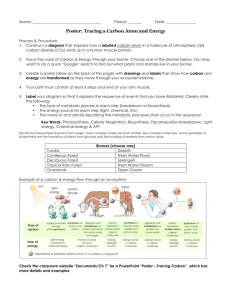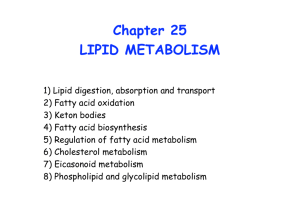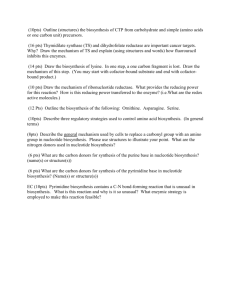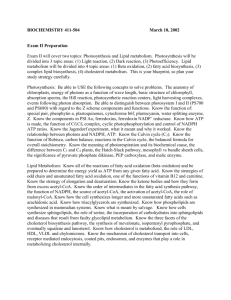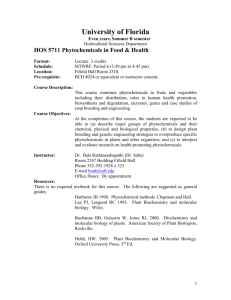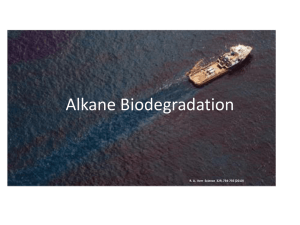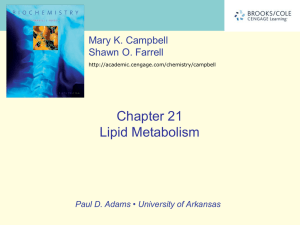Synthesis and degradation of fatty acids
advertisement
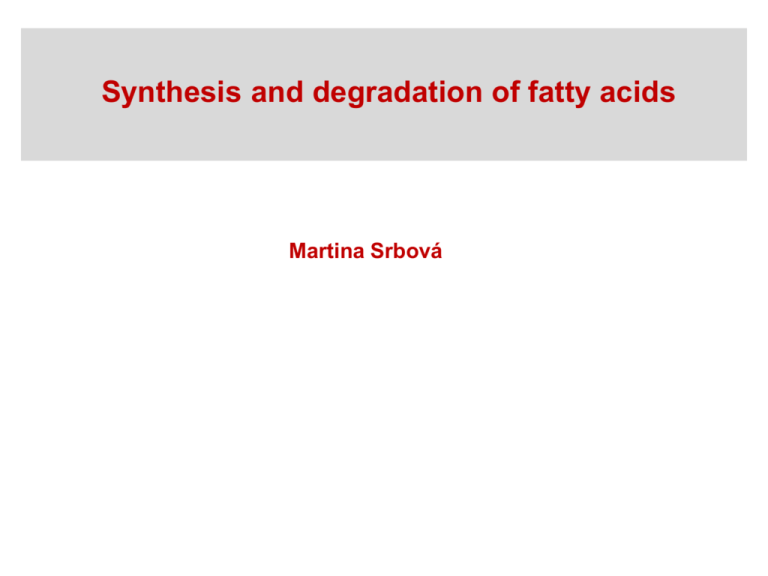
Synthesis and degradation of fatty acids Martina Srbová Fatty acids (FA) mostly an even number of carbon atoms and linear chain in esterified form as component of lipids in unesterified form in plasma binding to albumin Groups of FA: according to the chain length <C6 C6 – C12 C14 – C20 >C20 short-chain FA (SCFA) medium-chain FA (MCFA) long-chain FA (LCFA) very-long-chain FA (VLCFA) according to the number of double bonds no double bond one double bond more double bonds saturated FA (SAFA) monounsaturated FA (MUFA) polyunsaturated FA (PUFA) Overview of FA FA biosynthesis mainly in the liver, adipose tissue, mammary gland during lactation (always in excess calories) localization: cell cytoplasm (up to C16) endoplasmic reticulum, mitochondrion (elongation = chain extension) enzymes: acetyl-CoA-carboxylase (HCO3- - source of CO2, biotin, ATP) fatty acid synthase (NADPH + H+, pantothenic acid) primary substrate: acetyl-CoA final product: palmitate Precursors for FA biosynthesis 1. Acetyl-CoA source: oxidative decarboxylation of pyruvate (the main source of glucose) degradation of FA, ketones, ketogenic amino acids transport across the inner mitochondrial membrane as citrate 2. NADPH source: pentose phosphate pathway (the main source) the conversion of malate to pyruvate (NADP+-dependent malate dehydrogenase - „malic enzyme”) the conversion of isocitrate to α-ketoglutarate (isocitrate dehydrogenase) Precursors for FA biosynthesis Acetyl-CoA + HSCoA OAA - oxaloacetate FA biosynthesis Formation of malonyl-CoA catalysed by acetyl-CoA-carboxylase (ACC) HCO3- + ATP ADP + Pi enzyme-biotin-COO- enzyme-biotin 1 carboxylation of biotin 2 transfer of carboxyl group to acetyl-CoA acetyl-CoA formation of malonyl-CoA + enzyme – acetyl-CoA-carboxylase malonyl-CoA enzyme-biotin FA biosynthesis on the multienzyme complex – FA synthase repeated extension of FA by two carbons in each cycle to the chain length C16 (palmitate) ACP – acyl carrier protein FA biosynthesis The course of FA biosynthesis acetyl-CoA malonyl-CoA CoASH CoASH acetyltransacylase malonyltransacylase transacylation acyl(acetyl)-malonyl-enzyme complex FA biosynthesis The course of FA biosynthesis 3-ketoacyl-synthase CO2 condensation acyl(acetyl)-malonyl-enzyme complex 3-ketoacyl-enzyme complex (acetacetyl-enzyme complex) FA biosynthesis The course of FA biosynthesis NADPH + H+ + NADPH + H+ NADP NADP+ H2O 3-ketoacyl-reductase first reduction 3-ketoacyl-enzyme complex (acetoacetyl-enzyme complex) 3-hydroxyacyldehydrase dehydration 3-hydroxyacyl-enzyme complex enoylreductase second reduction 2,3-unsaturated acyl-enzyme complex acyl-enzyme complex FA biosynthesis Repetition of the cycle malonyl-CoA CoASH acyl-enzyme complex (palmitoyl-enzyme complex) FA biosynthesis The release of palmitate thioesterase + H2O palmitate palmitoyl-enzyme complex FA biosynthesis The fate of palmitate after FA biosynthesis acylglycerols cholesterol esters ATP + CoA AMP + PPi palmitate acyl-CoA-synthetase esterification palmitoyl-CoA elongation desaturation acyl-CoA FA biosynthesis FA elongation 1. microsomal elongation system in the endoplasmic reticulum malonyl-CoA – the donor of the C2 units NADPH + H+ – the donor of the reducing equivalents extension of saturated and unsaturated FA FA > C16 elongases (chain elongation) 2. mitochondrial elongation system in mitochondria acetyl-CoA – the donor of the C2 unit not reverse β-oxidation palmitic acid (C16) fatty acid synthase FA biosynthesis FA desaturation in the endoplasmic reticulum enzymes: desaturase, NADH-cyt b5-reductase process requiring O2, NADH, cytochrome b5 stearoyl-CoA + NADH + H+ + O2 4 desaturases: double bonds at position 4,5,6,9 linoleic, linolenic – essential FA oleoyl-CoA + NAD+ + 2H2O FA biosynthesis - summary • Formation of malonyl-CoA • Acetyl-CoA-carboxylase • FA synthesis Palmitic acid • FA Synthase– cytosol Saturated fatty acids(>C16) Elongation systems- mitochondria, ER Unsaturated fatty acids Desaturation system - ER - FA degradation function: major energy source (especially between meals, at night, in increased demand for energy intake – exercise) release of FA from triacylglycerols in adipose tissue into the bloodstream binding of FA to albumin in the bloodstream transport to tissues 1 entry of FA into target cells 3 transfer of acyl-CoA via carnitine system into mitochondria 4 5 2 activation to acyl-CoA β-oxidation In the liver , acetyl CoA is converted to ketone bodies FA degradation -carbon -oxidation C10 , C12 http://che1.lf1.cuni.cz/html/Odbouravani_MK_3sm.pdf β-carbon -carbon β-oxidation -oxidation Branched FA VLCFA FA degradation β-oxidation mainly in muscles localization: mitochondrial matrix peroxisome (VLCFA) enzymes: acyl CoA synthetase carnitine palmitoyl transferase I, II; carnitine acylcarnitine translocase dehydrogenase (FAD, NAD+), hydratase, thiolase substrate: acyl-CoA final products: acetyl-CoA propionyl-CoA FA degradation β-oxidation repeated shortening of FA by two carbons in each cycle cleavage of two carbon atoms in the form of acetyl-CoA oxidation of acetyl-CoA to CO2 and H2O in the citric acid cycle complete oxidation of FA generation of 8 molecules of acetyl-CoA from 1 molecule of palmitoyl-CoA production of NADH, FADH2 reoxidation in the respiratory chain to form ATP PRODUCTION OF LARGE QUANTITY OF ATP FA degradation Activation of FA fatty acid ATP acyl-CoA-synthetase acyl adenylate pyrophosphate (PPi) acyl-CoA-synthetase pyrophosphatase 2Pi acyl-CoA AMP fatty acid+ ATP + CoASH PPi + H2O acyl-CoA + AMP + PPi 2Pi FA degradation The role of carnitine in the transport of LCFA into mitochondrion FA transfer across the inner mitochondrial membrane by carnitine and three enzymes: carnitine palmitoyl transferase I (CPT I) acyl transfer to carnitine carnitine acylcarnitine translocase acylcarnitine transfer across the inner mitochondrial membrane carnitine palmitoyl transferase II (CPT II) acyl transfer from acylcarnitine back to CoA in the mitochondrial matrix FA degradation Carnitine 3-hydroxy-4-N-trimethylaminobutyrate Sources: Exogenous: meat, dairy products Endogenous: synthesis from lysine and methionine Transported into the cell by specific transporter Deficiency: Decreased transport of acyl-CoA into mitochondria lipids accumulation myocardial damage muscle weakness Increased utilization of Glc hypoglycemia Similar symptoms are the genetically determined deficiency carnitinpalmitoyltransferase I or II FA degradation β-oxidation Steps of cycle: dehydrogenation acyl-CoA acyl-CoA-dehydrogenase oxidation by FAD creation of unsaturated acid trans-Δ2-enoyl-CoA hydration enoyl-CoA-hydratase addition of water on the β-carbon atom creation of β-hydroxyacid L-β-hydroxyacyl-CoA L-β-hydroxyacyl-CoA-dehydrogenase dehydrogenation oxidation by NAD+ creation of β-oxoacid cleavage at the presence of CoA β-ketoacyl-CoA β-ketoacyl-CoA-thiolase formation of acetyl-CoA formation of acyl-CoA (two carbons shorter) acyl-CoA acetyl-CoA FA degradation Oxidation of unsaturated FA the most common unsaturated FA in the diet: β-oxidation of oleic acids oleic acid, linoleic acid degradation of unsaturated FA by β-oxidation to a double bond Unsaturated FA are cis isomers - aren´t substrate for enoyl-coA hydratase 3 rounds of β-oxidation conversion of cis-isomer of FA by specific isomerase to trans-isomer intramolecular transfer of double bond from β- to - β position continuation of β-oxidation Normal intermediates of β-oxidation http://che1.lf1.cuni.cz/html/Odbouravani_MK_3sm.pdf FA degradation Oxidation of odd-chain FA shortening of FA to C5 propionyl-CoA stopping of β-oxidation HCO3- + ATP formation of acetyl-CoA and propionyl-CoA propionyl-CoA carboxylase (biotin) methylmalonyl-CoA carboxylation of propionyl-CoA intramolecular rearrangement to form succinyl-CoA ADP + Pi methylmalonyl-CoA mutase (B12) succinyl-CoA entry of succinyl-CoA into the citric acid cycle FA degradation Peroxisomal oxidation of VLCFA Very-long-chain FA (VLCFA, > C20) transport of acyl-CoA into the peroxisome without carnitine Differences between β-oxidation in the mitochondrion and peroxisome: 1. step – dehydrogenation by FAD mitochondrion: electrons from FADH2 are delivered to the respiratory chain where they are transferred to O2 to form H2O and ATP peroxisome: electrons from FADH2 are delivered to O2 to form H2O2, which is degraded by catalase to H2O and O2 3. step – dehydrogenation by NAD+ mitochondrion: reoxidation of NADH in the respiratory chain peroxisome: reoxidation of NADH is not possible, export to the cytosol or the mitochondrion FA degradation Peroxisomal oxidation of VLCFA Differences between β-oxidation in the mitochondrion and peroxisome: 4. step – cleavage at the presence of CoA acetyl-CoA mitochondrion: metabolization in the citric acid cycle peroxisome: export to the cytosol, to the mitochondrion (oxidation) a precursor for the synthesis of cholesterol and bile acids a precursor for the synthesis of fatty acids of phospholipids In peroxisome shortened FA bind to carnitine transfer acylcarnitine into mitochondrion acylcarnitine β-oxidation FA degradation - oxidation Oxidation carbon mixed function oxidase ER liver, kidney Substrates C10 a C12 FA Products: dicarboxylic acids Excreted in the urine Comparison of FA biosynthesis and FA degradation Ketone bodies Ketogenesis increased ketogenesis: lipolysis starvation prolonged exercise diabetes mellitus FA in plasma high-fat diet low-carbohydrate diet β-oxidation utilization of ketone bodies as an energy source (skeletal muscle, intestinal mucose, adipocytes, brain, heart etc.) excess of acetyl-CoA to spare of glucose and muscle proteins ketogenesis Ketone bodies Ketogenesis in the liver localization: mitochondrial matrix substrate: acetyl-CoA products: acetone acetoacetate medium strength acids - ketoacidosis D-β-hydroxybutyrate conditions: in excess of acetyl-CoA function: energy substrates for extrahepatic tissues Ketone bodies Ketogenesis Ketone bodies Ketogenesis acetoacetate spontaneous decarboxylation to acetone conversion to D-β-hydroxybutyrate by D-β-hydroxybutyrate dehydrogenase waste product (lung, urine) energy substrates for extrahepatic tissues Ketone bodies Utilization of ketone bodies water-soluble FA equivalents energy source for extrahepatic tissues (especially heart and skeletal muscle) in starvation - the main source of energy for the brain citric acid cycle energy production Bibliography and sources Devlin, T. M. Textbook of biochemistry: with clinical correlations. 6th edition. Wiley-Liss, 2006. Marks, A.; Lieberman, M. Marks' basic medical biochemistry: a clinical approach. 3rd edition. Lippincott Williams & Wilkins, 2009. Matouš a kol. Základy lékařské chemie a biochemie. Galén, 2010. Meisenberg, G.; Simmons, W. H. Principles of medical biochemistry. 2nd edition. Elsevier, 2006. Murray et al. Harper's Biochemistry. 25th edition. Appleton & Lange, 2000. http://www.hindawi.com/journals/jobes/2011/482021/fig2/
